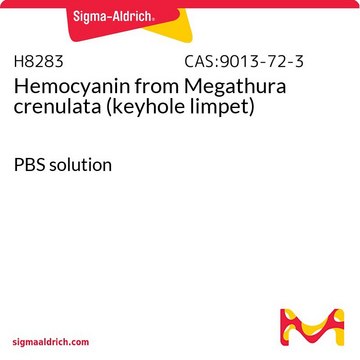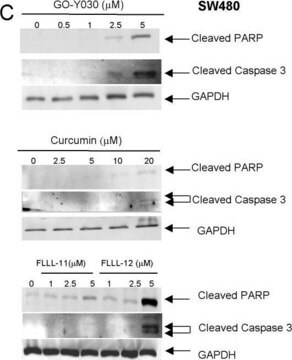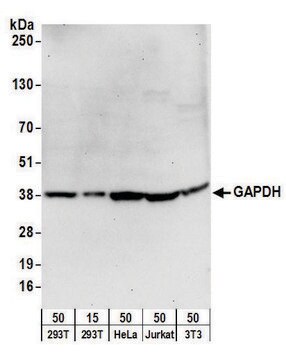H0892
Anti-Hemocyanin (KLH) antibody produced in rabbit
affinity isolated antibody, buffered aqueous solution
Sign Into View Organizational & Contract Pricing
All Photos(1)
About This Item
Recommended Products
biological source
rabbit
Quality Level
conjugate
unconjugated
antibody form
affinity isolated antibody
antibody product type
primary antibodies
clone
polyclonal
form
buffered aqueous solution
species reactivity
keyhole limpet
packaging
antibody small pack of 25 μL
technique(s)
indirect ELISA: 1:20,000
shipped in
ambient
storage temp.
−20°C
target post-translational modification
unmodified
General description
Hemocyanin is a large, multi-subunit respiratory protein present in arthropods and mollucs. They circulate extracellularly in hemolymph. Hemocyanins do not contain iron but bind oxygen at an active site containing copper atoms ligated by protein side chains.
Application
Anti-Hemocyanin (KLH) antibody produced in rabbit has been used in:
- immunocytochemistry{58
- }immunohistochemistry
- immunofluorescent staining
- immunoblotting
Applications in which this antibody has been used successfully, and the associated peer-reviewed papers, are given below.
Immunocytochemistry (1 paper)
Immunocytochemistry (1 paper)
Biochem/physiol Actions
Keyhole limpet hemocyanin has been used traditionally as a protein carrier for hapten-carrier conjugates in immunochemistry. Keyhole limpet hemocyanin (KLH) has been regarded as a superior carrier. Affinity isolated antibody to hemocyanin may be used as a control reagent for the preparation and immunization of hapten-carrier conjugates.
Physical form
Solution in 0.01 M phosphate buffered saline pH 7.4, containing 15 mM sodium azide
Disclaimer
Unless otherwise stated in our catalog or other company documentation accompanying the product(s), our products are intended for research use only and are not to be used for any other purpose, which includes but is not limited to, unauthorized commercial uses, in vitro diagnostic uses, ex vivo or in vivo therapeutic uses or any type of consumption or application to humans or animals.
Not finding the right product?
Try our Product Selector Tool.
Storage Class
12 - Non Combustible Liquids
wgk_germany
nwg
flash_point_f
Not applicable
flash_point_c
Not applicable
Choose from one of the most recent versions:
Certificates of Analysis (COA)
Lot/Batch Number
Don't see the Right Version?
If you require a particular version, you can look up a specific certificate by the Lot or Batch number.
Already Own This Product?
Find documentation for the products that you have recently purchased in the Document Library.
Antonio Castro et al.
Journal of chemical neuroanatomy, 35(4), 306-316 (2008-05-09)
Immunocytochemical techniques were used to investigate the appearance and distribution of calretinin in the olfactory system of developing and adult brown trout (Salmo trutta fario L.). The earliest calretinin-immunoreactive (CR-ir) cells were detected in the olfactory placode of 5-mm embryos.
Cecilia Thors et al.
The journal of histochemistry and cytochemistry : official journal of the Histochemistry Society, 51(10), 1367-1373 (2003-09-23)
KLH (Keyhole limpet hemocyanin) is highly immunogenic, and crossreactive epitopes occur widely in nature. In schistosomiasis, infected hosts generate antibodies reactive with KLH. This is of diagnostic importance but we lack detailed information on the immunogen-carrying molecules and their distribution
Serglycin in quiescent and proliferating primary endothelial cells
Reine TM, et al.
Testing, 10(12), e0145584-e0145584 (2015)
C Thors et al.
Parasite immunology, 20(10), 489-496 (1998-11-03)
The number of individuals catching schistosomiasis has increased with the popularity of 'primitive tourism' in Africa. Highly immunogenic material originating from the intestine of intravascular adult schistosomes gives rise to an antibody response making possible early identification of infected individuals
The Planorbid Snail Biomphalaria glabrata Expresses a Hemocyanin-Like Sequence in the Albumen Gland.
Janeth J Peña et al.
PloS one, 11(12), e0168665-e0168665 (2016-12-31)
The parasitic flatworm Schistosoma mansoni, causative agent of human intestinal schistosomiasis in South America, relies importantly on the freshwater snail Biomphalaria glabrata as intermediate host to achieve development of cercariae that infect humans. The recommendation from the World Health Organization
Our team of scientists has experience in all areas of research including Life Science, Material Science, Chemical Synthesis, Chromatography, Analytical and many others.
Contact Technical Service








